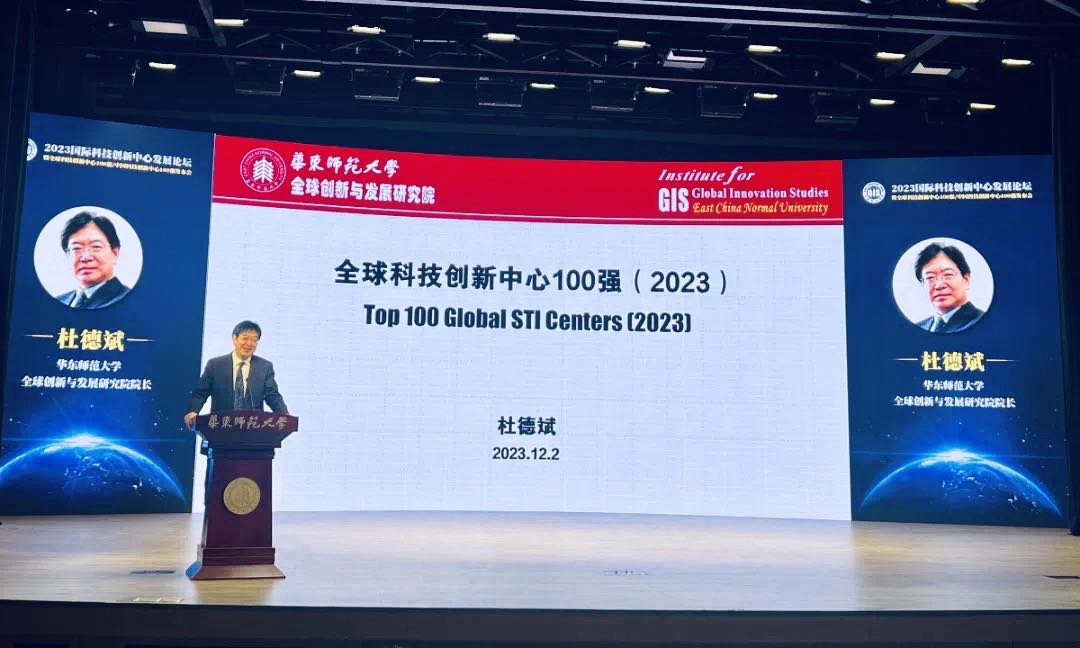Chinese cities have climbed to the second position, just behind the US, in the top 100 most advanced cities in science and technology innovation globally after 10 years since the proposal of constructing science and technology innovation centers in China in 2013, according to a ranking released on Saturday.

Du Debin, director of the East China Normal University Institute for Global Innovation Studies and chairman of Shanghai Society for Science of Science delivers the ranking of Top 100 Global Science and Technology Innovation Centers 2023 on December 2, 2023. Photo: Du Qiongfang/GT
According to the ranking of Top 100 Global Science and Technology Innovation Centers 2023 (2023 GIS 100), released by East China Normal University (ECNU) Institute for Global Innovation Studies, during an international forum on innovation and development of science and technology in Shanghai, 140 cities across the world were scientifically evaluated by the research team from five dimensions including global clustering abilities of innovation factors, global leadership of scientific research, global original breakthroughs of technological innovation, global driving force of industrial transformation and global support of innovation environment.
Among the top 100 global science and technology innovation centers, 95 cities are located in three major regions: Europe, North America and the Asia-Pacific. Specifically, there are 33 cities in Europe, 30 in North America and 32 in the Asia-Pacific region.
This indicates a further strengthening of the global innovation “big triangle” pattern dominated by the three regions, Du Debin, director of the ECNU Institute for Global Innovation Studies and chairman of Shanghai Society for Science of Science, who led the research team and delivered the ranking report, said on Saturday.
The large amount of data the research team obtained in the process of compiling the ranking was the biggest gain and the most valuable material collected during their work which can be referred to when working out the strategy for the construction of the science and technology innovation centers in China, Du told the Global Times on Saturday.
According to the ranking, the San Francisco-San Jose region in the US is the world’s top scientific and technological innovation center. It holds the first position across three dimensions.
The total investment of the top 10 enterprises in Silicon Valley in the San Francisco-San Jose region amounted to 104.7 billion euros ($114.29 billion) in 2021. This is significantly higher than the 32.7 billion euros in Shenzhen, Guangdong Province, China. Beijing followed with 29.13 billion euros and Shanghai with 11.1 billion euros. This data is considered a crucial indicator that reflects a city's future trend in innovation development, according to Du.
Comparing China and the US, the number of science and technology innovation centers from the US remained stable at 26, with a dominant presence of 12 positions in the top 30 and four in the top 10. The San Francisco-San Jose region has maintained its position as the world’s top science and technology innovation center.
Among the global top 100, there are 23 cities from China, taking up 5 positions in the top 30, second only to the US in quantity. Beijing has risen to the 4th position from last year’s fifth position in the comprehensive ranking, surpassing Tokyo in Japan to become the top-ranking city in the Asia-Pacific region. Shanghai maintained its global 10th position, ranking the first nationwide in the global driving force of industrial transformation.
The top 10 global science and technology innovation centers include the San Francisco-San Jose region, New York, London, Beijing, Tokyo, Boston, Paris, Seoul, Los Angeles and Shanghai.
During the Saturday forum, the ECNU Institute for Global Innovation Studies also released the 2023 ranking of Top 100 Science and Technology Innovation Centers in China, which shows that 45 cities among the top 100 are located in the three city clusters of the Beijing-Tianjin-Hebei region, the Yangtze River Delta and the Pearl River Delta.
Xing Hexiang, executive dean of the Industrial Technology Research Institute from the ECNU explained that the T-shaped structure formed by the eastern coastal areas and the Yangtze River Economic Belt constitute the two major zones for China’s science and technology innovation centers to grow.
Article Source:GLOBAL TIMES
Original link:https://enapp.globaltimes.cn/article/1302894

